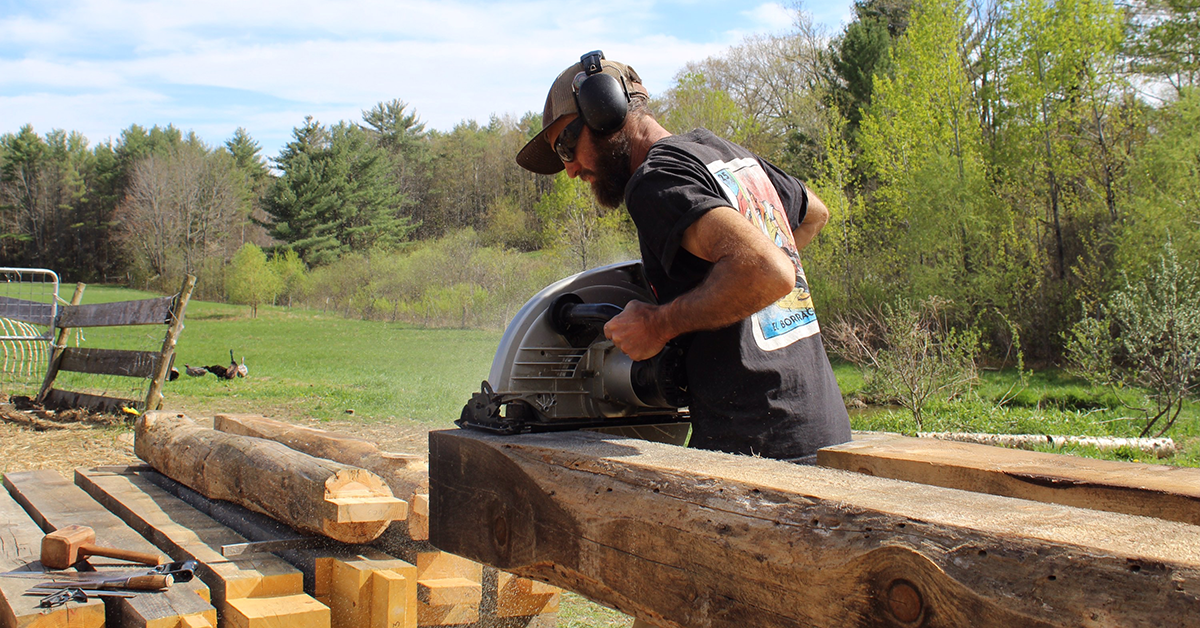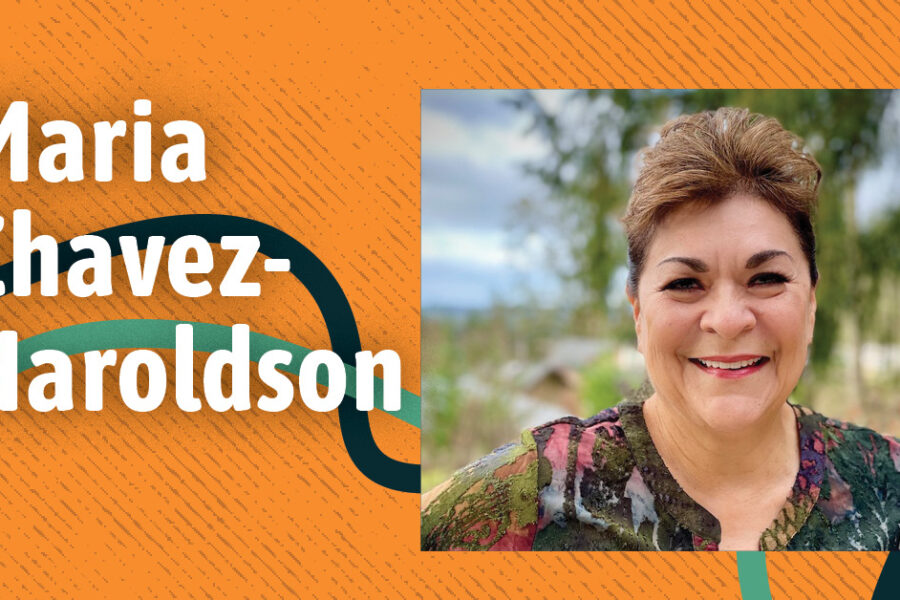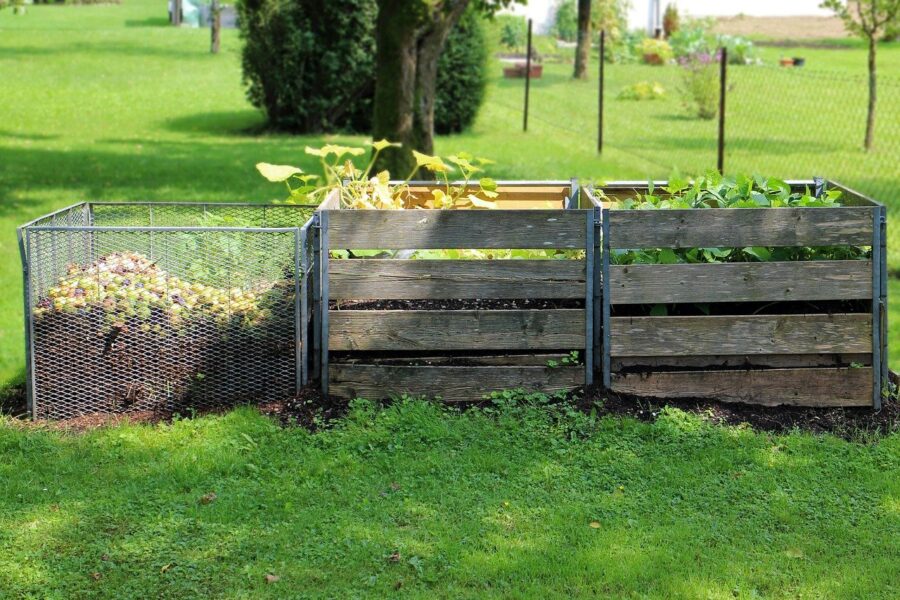Marty Castriotta considers himself an ecosystem designer. The alum of Antioch New England’s Environmental Education program says, “Permaculture design offers a toolkit.” These tools mimic natural systems—minimizing waste, using natural building materials—and they create long-term models for how we as a society can grow food in a more sustainable way. Castriotta has used this philosophy of interconnection to build his own farm, Village Roots Permaculture, with his partner Ellen Denny. Through his farm, his consulting work, and also his writing, Castriotta is using the tool-kit of permaculture to support people growing food in ways that enhance ecological vitality. And this mission is part of what led him to collaborate with Ellis Farm, the nexus for Antioch-related environmental leaders. At Ellis Farm, Castriotta found another space to help others working towards sustainable farming.
Antioch Connections Growing in New Soil
Castriotta first visited Ellis Farm four years ago. Looking around, he immediately noticed the land around the homesite had been heavily impacted by logging and machinery. It was apparent much of the topsoil had been stripped away when a previous owner had cleared the area. What was left of the soil was so rocky there was little water retention—a necessary starting point for any permaculture system. Massive piles of stumps and roots were plowed up against the tree lines of the property.
Ellis Farm, recently profiled in the Antioch Alumni Magazine, was founded by Antioch’s Director of Institutional Development Laura Andrews and Environmental Studies PhD alum Cary Gaunt. Castriotta had known the couple for over twenty years, since meeting them through the PhD in Environmental Studies. Their common interests had kept them connected over the decades. That was why, when Andrews and Gaunt realized they were going to need many hands to restore the site, Castriotta was among the first people they called. And after surveying their land, Castriotta quickly knew that he could be of use.
Castriotta asked Gaunt and Andrews about their visions for the land. They were both ecologically minded and had a clear goal about what they wanted the space to grow into: a sustainable model of farming that supported the land, people, and animals in an interconnected way.
The group walked the site and assessed how the land was used in the past, the topography, orientation to the sun, and what plants were growing there already that could tell them about the existing soil. Castriotta was able to see where the problem areas were for Ellis Farm. They started mapping right away. Before long the problems seemed like possibilities. The work they had to do was threefold: build topsoil, capture and sink water, and start enhancing biological diversity.
A Rocky Start at Ellis Farm
In permaculture circles, says Castriotta, “There’s this saying, ‘The problem is the solution.’” This means that you really have to understand the problems, though. For Castriotta, that means seeing the holes in current agricultural systems, which in turn requires looking at each component in relation to one another. This lens can be applied to the smallest physical details, like how the size of soil particles affect drainage. It can also be applied to big ideas—like building community and sharing skills. What permaculture teaches is that every part matters, from the chicken helping with pest control, to the rain that fills irrigation systems, to the people who help each other figure out the best ways to make it all work.

“Usually, the problem is the starting point,” Castriotta says. That’s the place where you can make the biggest changes—and because everything is connected those changes ripple through. The problem at Ellis farm was the soil. With help from the KSC Garden Club, they cleared rocks, pruned, and prepared a future pollinator patch. They removed and collected so many stones, they were actually able to build a fire pit. Castriotta says, “All in all we tracked almost 30 volunteer hours from KSC students and Village Roots interns.”
But getting rid of the rocks was just the start. Soil needs organic material to hold water and provide nutrients to plants, and there was very little topsoil around the homestead. They didn’t have to look far for a solution, though. Across the street from the farm is the Elm Research Institute, and that property had mounds and mounds of wood chips. There were new and ancient piles as far as you could see. “Football fields full of life—carbon piles,” Castriotta says.
Utilizing the abundant resources, Castriotta decided to build huge “hugel beds” for the farm. Hugel beds are raised gardens constructed out of mostly woody debris (carbon) covered with layers of compost, topsoil and mulch. Castriotta wanted to use this method of planting to not only create topsoil but as a means to put each component in better relation with each other. Hugel beds are a great way to build fertility quickly, hold moisture, and sequester carbon.
“He is wonderful,” says Andrews. “Marty and the other permaculture specialists took wood chips from the adjacent property and compost, created a big hole, and then threw all of those materials together, sculpting them and leveling out the land so that we could garden.”
A third of the site was transformed into a future garden and orchard area. The future orchard now sits on many feet of organic material that will be a long-term reservoir for nutrients and water, as well as a carbon sink. The hugel bed is even placed where it captures the rainwater that slips off the back of the house. “Due to Marty’s work,” Andrews says, “the soil in those beds is now filled with worms and ready for planting.”
Seeds of Change Planted in Village Roots Permaculture
Much of Castriotta’s experience with permaculture comes from working on the farm he started with his partner, Ellen Denny. The two also met during their time at Antioch in the Environmental Education program. And they started their farm, Village Roots Permaculture, a year later with a mission to grow soil and community.

Not only do they care for the flora and fauna on their land, but they both also teach about food, farming, and permaculture design. Castriotta says, “We grow food forests, as well as vegetables, sheep, cows, pigs, chickens, turkeys, ducks, and geese.” Village Roots aims to build resilient and regenerative edible ecosystems that enhance access and community connection.
Castriotta says his passion for growing food came from Denny. When they met, she had just completed a farm internship on an organic farm and was devoted to teaching others about the ecological and social importance of growing organic food. He was a builder at the time. As they were plowing through permaculture books together, he realized the importance of building human habitats. Now, he says, “I always envision a world where we can eat within our own ecosystem.”
Inspiring Future Permaculture Designers with Family
While Castriotta continues to farm, design, teach and build, he’s also writing his latest book, Emerging Patterns of Resilience: Permaculture in Action in the Northeast. He says, “There’s a lot of great permaculture books out there, but the word is shrouded in a little bit of confusion.” His new book explains the permaculture approach to land management and aims to make the design process more digestible, accessible, and easy to understand. Castriotta says, “I want it to be something that anyone of any age could find useful.”

Castriotta’s book is rooted in his decades of work with Village Roots, but it is also an assessment of patterns in the Northeast that readers can look to for aid and inspiration in a changing climate. It will represent the best permaculture design strategies and the ecological and indigenous land use that informed and inspired such design. He is working on this project with his niece, artist, and ecologist, Abigail Castriotta. “I couldn’t be more fortunate to have Abbie as my partner,” he says. Abigail Castriotta is an artist who has been trained in ecology.“She’s got this amazing mix of things that make her the perfect candidate for being able to understand what I’m writing and turn it into a visual representation,” says Castriotta. As a recent graduate who studied permaculture through classes and internships, Abigail Castriotta recognized the value of the book, which aligned with her passion for food security. With degrees in Environmental Studies and in Studio Art, she says she is excited to combine her passion for permaculture and art as she illustrates the book. She wants her illustrations to depict emerging patterns of resilience—to help readers envision thriving ecological, social, and economic systems.
The most important motivation for both of the authors is to inspire the next generation of permaculture designers to be active co-creators and designers of edible and abundant food landscapes. Like the many small details that go into permaculture to create a thriving ecosystem, Castriotta sharing his knowledge and experience will continue to create fertile soil for new growth in the future.






